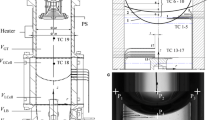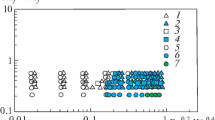Abstract
Experiments have been performed to investigate thermal effects on the dynamic contact angle of an advancing meniscus. The situation is similar to the capillary transport of propellant along vanes in tanks of spacecrafts or the capillary rise of propellant along the hot tank wall entering the ballistic phase after the end of thrust. The results show that the dynamic contact angle depends on the ratio of viscous forces to capillary forces (Capillary number) as well as on the Marangoni forces due to surface tension gradients along the liquid interface caused by the non-isothermal boundary condition. The occurrence of a Marangoni flow causes an increase of the apparent dynamic contact angle. Experiments at isothermal conditions show good agreement with the dynamic contact angle model from Jiang et al. [1]. Thus we used his correlation as a basis for a dynamic contact angle model in the nonisothermal case. Our assumption is that the increase of the dynamic contact angle is caused by a shift of the static contact angle. We modified the model from Jiang in a way that we substitute the static isothermal contact angle by a shift contact angle. A relation has been determined for this shift contact angle in dependence on the thermocapillary Reynolds Marangoni number and the ratio of the Weber number and the thermocapillary Weber number. The knowledge of the behavior of the dynamic contact angle at non-isothermal conditions can be used to predict the flow behavior on a larger scale.
Similar content being viewed by others
References
T. S. Jiang, S. O. Oh, andJ. C. Slattery. “Correlation for dynamic contact angle”. J. Colloid Interface Sci., 69:74–77, 1979.
O.V. Voinov. Encyclopedia of Surface and Colloid Science, Dynamics of wetting of a solid by a liquid: movement of thin liquid films, pages 1546–1559. Marcel Dekker, New York, 1976.
M. Bracke, F. de Voeght, andP. Joos. “The kinetics of wetting: The dynamic contact angle”. Progr. Colloid Polym. Sci., 79:142–149, 1989.
G. Friz. Über den dynamischen Randwinkel im Fall der vollständigen Benetzung. Z. angew. Phys., 19:374–378, 1965.
P.-G. de Gennes, F. Brochard-Wyart andD. Quere. Drops, Bubbles, Pearls, Waves. Springer, New York, 2004.
S. Ostrach. “Low-gravity fluid flows”. Annu. Rev. Fluid Mech., 14:313–345, January 1982.
Author information
Authors and Affiliations
Corresponding author
Additional information
Keynote Lecture was presented on the Second International Topical Team Workshop on TWO-PHASE SYSTEMS FOR GROUND AND SPACE APPLICATIONS October 26–28, 2007, Kyoto, Japan
Rights and permissions
About this article
Cite this article
Gerstmann, J., Dreyer, M.E. The dynamic contact angle in the presence of a non-isothermal boundary condition. Microgravity Sci. Technol 19, 96–99 (2007). https://doi.org/10.1007/BF02915764
Received:
Revised:
Accepted:
Issue Date:
DOI: https://doi.org/10.1007/BF02915764




